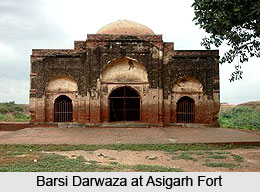 Asigarh Fort is also referred to as Prithviraj Chauhan Fort or `Prithvi Raj Chauhan ka Qila` and is present in the town of Hansi, in the northern Indian state of Haryana. This historical structure has been proclaimed a `protected monument` by the Archaeological Survey of India. Presently, Asigarh Fort has been transformed into a mound and consists of a pillared structure equipped with a flat terrace which is located on the upper portion of the mound, known as `Baradari`. The fort is square-shaped and occupies an area measuring 30 acres, surrounded by security posts in four of its corners. Certain records composed by Qazi Sharif Husain in Talif-e-Tajkara-e-Hansi in the year 1915 assert that approximately 80 different regional forts were supervised from this very fort.
Asigarh Fort is also referred to as Prithviraj Chauhan Fort or `Prithvi Raj Chauhan ka Qila` and is present in the town of Hansi, in the northern Indian state of Haryana. This historical structure has been proclaimed a `protected monument` by the Archaeological Survey of India. Presently, Asigarh Fort has been transformed into a mound and consists of a pillared structure equipped with a flat terrace which is located on the upper portion of the mound, known as `Baradari`. The fort is square-shaped and occupies an area measuring 30 acres, surrounded by security posts in four of its corners. Certain records composed by Qazi Sharif Husain in Talif-e-Tajkara-e-Hansi in the year 1915 assert that approximately 80 different regional forts were supervised from this very fort.
History of Asigarh Fort
Asigarh Fort had been constructed during the 12th century by the emperor Prithviraj Chauhan and was rebuilt in the year 1798 by George Thomas. This was created just after Thomas was capable of determining the borders of his own territories Rohtak and Hisar districts, while Hisar was made his official capital. A cantonment was erected within the premises of this Indian fort following the surrender of George Thomas to the British Raj in the nation, during 1803. However, this cantonment was deserted and Asigarh Fort was destroyed after the Sepoy Mutiny of 1857.
Architecture of Asigarh Fort
The fort has been established in such a unique process which ensures that it remains impenetrable in any and every circumstance. The walls of Asigarh Fort measures nearly 52 feet in height and 37 feet in width. Visitors would observe a large gate on the southern part of the Asigarh Fort which had been added much later by George Thomas. Walls of the fort boast of architectural styles which are exclusive to Hindu architecture. Inside the fort complex is existent a mosque which is a later addition, following the capture of the ruler Prithviraj Chauhan. During the regime of Firoz Shah Tughlaq, an underground tunnel was built in order to connect Hisar and Hansi, inside the Asigarh Fort. The gates of Asigarh Fort are beautifully decorated with figures of Gods while its walls are adorned with the figurines of Goddesses, animals and birds.



















